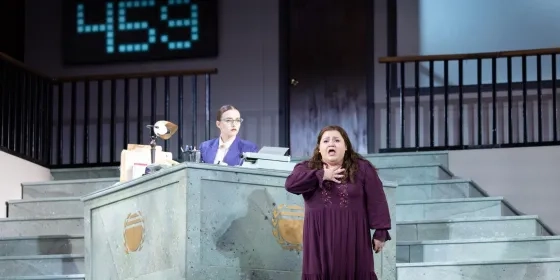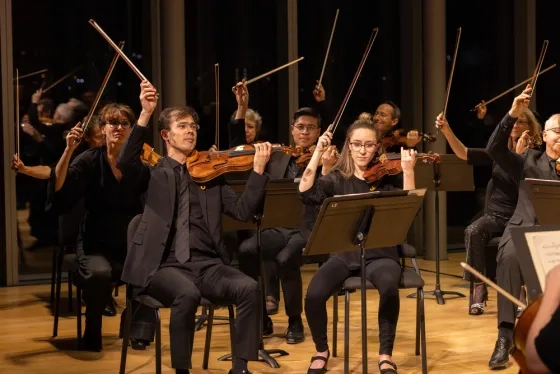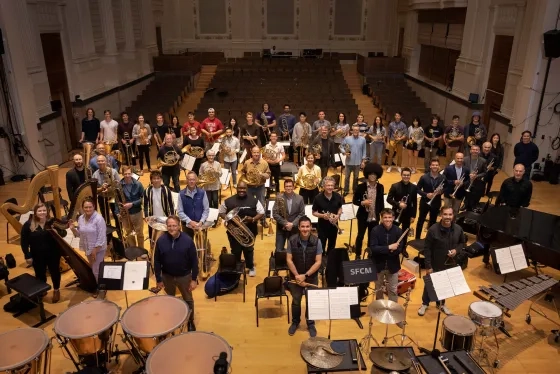A New Conservatory Model
A look at some of the most frequently asked questions about SFCM’s innovative partnerships in artist management and recording.
In December 2022, the San Francisco Conservatory of Music (SFCM) announced—along with its existing partners Opus 3 Artists and Pentatone—that it would acquire the London-based artist management company Askonas Holt, thus growing its network in the classical music ecosystem.
“We had a series of ideas of what the modern conservatory should be, and that it shouldn’t just be limited to a ‘conservatory’ anymore,” said SFCM President David Stull.
From the beginning, SFCM and its partners shared a common mission to increase access to music in the world and to evolve the nature of how students, artists, staff, and patrons interact with one another.
Now, they are coming together to further align their operations and develop collective projects. Along the way, the organizations are working to deliver experiences only available at SFCM.
Examples this semester include a side-by-side strings student performances with resident artists Academy of St Martin in the Fields, a fully-staged opera production of The Consul directed by soprano Patricia Racette, and a joint concert with Canadian Brass—among other collaborations.
As activations of the alliance continue, below are answers to some of the most frequently asked questions about the initiative.
What is SFCM’s new alliance?
SFCM leads an alliance consisting of two leading artist management companies, Askonas Holt and Opus 3 Artists, the storied record label Pentatone, and the Conservatory. Each company was independently acquired through a holding company led by members of the SFCM Board of Trustees. The entities operate independently but work together on projects that create opportunities for students, artists, and the public.
How did SFCM afford to acquire the management companies and record label?
All funds to acquire SFCM’s subsidiary companies were made available through private donations. No endowment, scholarship, or SFCM operating funds were utilized for this purpose.
How does this new alliance benefit students? What about artists?
The alliance makes resources and expertise from across the entities more easily accessible to one another. This includes financial support from the for-profit companies used to fund programs and activities benefiting students and artists.
So far, students have participated in multiple projects on campus enabled by SFCM’s alliance with Opus 3, Askonas Holt, and Pentatone that were only possible because of the close relationship between the Conservatory and its partners.
What’s more, the alliance creates the conditions for students, artists, and industry professionals to experiment. As it evolves, students and artists can expect to invent and produce original performances together on campus, partner for internships, and share recording studios or other physical resources across alliance offices in San Francisco, New York, London, Berlin and Amsterdam.
What are examples of projects born from the alliance?
In the context of spring 2020’s ongoing pandemic, SFCM students and faculty undertook initial projects with Opus 3 Artists. Early collaborations featured masterclasses and residencies, including with pianist Shai Wosner and violinist Stefan Jackiw, the debut of student compositions for Aquila Theatre Company’s interpretation of The Great Gatsby, and the technological reimagination of the centuries-old opera La Clemenza di Tito in a partnership between students and creative producer and director James Darrah.
In May 2022, SFCM and Opus 3 Artists announced their joint Artist Apprentice Program, a mentorship initiative that pairs seasoned managers with outstanding early-career musicians and a network of bespoke support for the individual. Sphinx competition winner and SFCM Pre-College student Amaryn Olmeda was named its first member, becoming the youngest artist on the Opus 3 roster.
That summer, the National Brass Ensemble reunited to record an album for Pentatone at Skywalker Sound and to perform at Davies Symphony Hall, both under the direction of SF Opera Music Director Eun Sun Kim. The events were part of SFCM’s National Brass Ensemble Academy, a week-long, intensive training program for young brass players. The album is expected out this spring.
An ongoing collaboration will pair SFCM students in the Technology and Applied Composition (TAC) program with Pentatone’s engineers to mix recordings utilizing Spatial Audio with Dolby Atmos technology, supplying students with real-world involvement and credits on commercial releases while saving costs for the label and enhancing their listeners’ experiences.
Even more about this semester’s ongoing collaborations can be found here.
What does it mean for Askonas Holt and Opus 3 Artists to share a CEO?
Askonas Holt and Opus 3 Artists are long-time collaborators and friends. The appointment of widely respected leader Donagh Collins to serve as CEO of both entities is a natural extension of that connection and a shared vision, though the entities continue to operate autonomously and within pre-existing management structures.
What is the difference between a non-profit and a for-profit?
Non-profits do not distribute profit anywhere other than furthering the advancement of the organization. They generally serve a social mission and provide public benefits. Non-profit organizations include hospitals, universities, charities, and foundations.
For-profit organizations operate with the goal of making money, typically by selling a product or service.
How is it possible that a non-profit, like SFCM, acquired for-profit entities?
Non-profit organizations may create or own a subsidiary or entities with either for-profit or non-profit structures, though certain regulations apply.
One potentially illustrative model is the academic medical center, which combines the strengths of physicians, nurses, researchers, teachers, and students to improve patient outcomes by developing and delivering new technologies, drug trials, and medical breakthroughs while investing in future generations of healthcare providers. These ecosystems may contain both non-profit hospitals or schools and for-profit ventures, such as wellness centers, rehabilitation facilities, home nursing companies, or consulting services.
What’s being said about SFCM’s new alliance?
In addition to the many news articles announcing SFCM’s partnerships, below you can find a snapshot of commentary about the model:
- A New Model for a Music Conservatory, by Ted Gioia, The Honest Broker, May 2022
"I now look at the total picture, and I see SFCM pursuing an ambitious strategy that encompasses the entire music ecosystem … No other conservatory in the world has anything close to their presence in technology, recording, music distribution, career development, concert bookings, and even music journalism. And all of this, of course, is in addition to the performance and composition pedagogy that is at the heart of every music education institution." – Ted Gioia, author, critic, and co-founder of jazz studies at Stanford University
- Lessons in Harmony, by Carlton Wilkinson, Brunswick Review, June 2022
- Artist Managers: A Golden Gated Opportunity, by Andrew Green, Classical Music, January 2023
- An Update on San Francisco Conservatory’s New Model After Purchase of Music Label and Concert Agencies, by Laurence Vittes, Strings, March 2023
To learn the latest news from SFCM, please visit our newsroom or sign up for “Take Note,” our monthly email newsletter.


